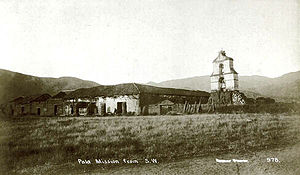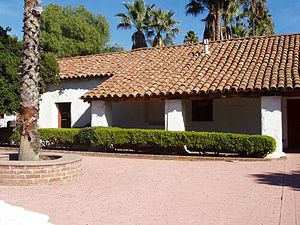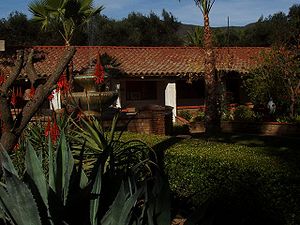- San Antonio de Pala Asistencia
-
San Antonio de Pala Asistencia
The modern capilla (chapel) at "Pala Mission."Location San Diego County Name as founded Asistencia de la Misión San Luis, Rey de Francia [1] English translation Sub-Mission to the Mission San Luis Rey de Francia Patron Saint Anthony of Lisbon, Portugal and Padova, Italy [1] Founding date June 13, 1816 [2] Founding priest(s) Father Antonio Peyrí [1] Military district First Native tribe(s)
Spanish name(s)Payomkowishum
LuiseñoNative place name(s) Pale [3] Governing body Roman Catholic Diocese of San Diego Current use Parish Church / Museum Coordinates 33°21′40″N 117°04′45″W / 33.36111°N 117.07917°W California Historical Landmark #243 Website http://www.missionsanantonio.org/ The San Antonio de Pala Asistencia, or the "Pala Mission", was founded on June 13, 1816 as an asistencia ("sub-mission") to Mission San Luis Rey de Francia, some twenty miles inland upstream from the mission on the San Luis Rey River. It was part of the Spanish missions, asistencias, and estancias system in Las Californias—Alta California. Today it is located in the Pala Indian Reservation located in northern San Diego County, with official name is now Mission San Antonio de Pala.[2][4] It is the only historic mission facility still serving a Mission Indian tribe.
Pala (a derivation of the native term Pale, meaning water) was essentially a small rancho surrounded by large fields and herds. The Pala site had been noted by Father Juan Mariner and Captain Juan Pablo Grijalva on an exploratory trip in 1795, when they went up the San Diego River, and then through Sycamore Canyon to the Santa Maria Valley (or Pamó Valley) and into what they named El Valle de San José, now known as Warner Springs. Once Mission San Luis Rey began to prosper, its existence attracted the attention of large number of mountain Native Americans, called the Luiseño by the Spanish.
Contents
Spanish era
The site for the Pala Mission was selected because it already was a traditional gathering place and village for the Native American residents. Father Peyrí oversaw the addition of a chapel and housing to the granary complex that was constructed at the spot in 1810.[4] The chapel has interior wall surfaces featured paintings by native artists, originally measured 144 by 27 feet. Workers went into the Palomar Mountains and cut down cedar trees for use as roof beams.[5] Pala is unique among all of the Franciscan missions in that it boasts the only completely freestanding campanile, or "bell tower," in all of Alta California. By 1820, some 1,300 baptisms had been performed at the outpost.[6] Folk tales about the mission all include mention of a prickly pear cactus, a symbol of Christian victory, that grew up at the foot of the cross.[7]
Mexican era
The Mexican Congress passed An Act for the Secularization of the Missions of California on August 17, 1833 (the Act was ratified in 1834).[8] Father Buenaventura Fortuna surrendered Mission San Luis Rey and all its holdings, including Las Flores Estancia and the Pala Asistencia, to government comisianados (commissioners) Pío Pico and Pablo de la Portillà on August 22, 1835; the assessed value of "Rancho de Pala" was $15,363.25.[9] Fearful of the impending conquest of Alta California by the United States, Pico sold off all of the holdings (including Pala) to Antonio J. Cot and José A. Pico on May 18, 1846 for $2,000 in silver and $437.50 in wheat (the sale was later declared invalid by the U.S. Government).[6] Through the years, priests from San Luis Rey continued to visit Pala and conduct baptisms, marriages, and worship services.
 Pala Asistencia, with its original bell tower, circa 1875. The structure is loosely styled after a similar one at the Mission of Nuestra Señora de Guadalupe located in Juárez, Mexico.[10]
Pala Asistencia, with its original bell tower, circa 1875. The structure is loosely styled after a similar one at the Mission of Nuestra Señora de Guadalupe located in Juárez, Mexico.[10]
Modern era
On Christmas Day, 1899 the San Jacinto Earthquake shook the Pala Valley, causing the rook over the church sanctuary to collapse.[11] In 1902, a group calling itself the "Landmarks Club of Southern California", under the direction of American journalist, historian, and photographer Charles Fletcher Lummis, purchased Pala Mission. The following year, the Club returned ownership to the Catholic Church and "...saved the Chapel and a few rooms from complete ruin with a timely work of partial restoration...".[12]
Pala is alone among the California missions in that it that has ministered without interruption to the Mission Indians for whom it was originally built since its inception.[11] It is also the only sub-mission (Asistencia) still intact. The traditional Corpus Christi Fiesta has been celebrated every year since its founding. Though it lacked a resident priest, Pala nonetheless served as the "mother" mission to chapels in Cahuilla, La Jolla, Pauma, Pichanga, Rincon, Santa Rosa, and Temecula.[13] On August 9, 1942 MGM motion picture actress Ruth Hussey was wed at Pala Mission. In 1948 the Verona Fathers (Sons of the Sacred Heart) succeeded the Franciscans in the care of the Mission.[14] Six years later, the fathers undertook a complete restoration of the Mission. In May, 1991 administration of the Mission reverted to the Roman Catholic Diocese of San Diego, and since June of 1996 the Barnabite Fathers have held charge over the Mission's affairs.
Mission bells
Bells were vitally important to daily life at any mission. The bells were rung at mealtimes, to call the Mission residents to work, religious services, birth and funeral ceremonies, and to signal the approach of a ship or returning Spaniard, and other occasions. Novices were instructed in the specific rituals for ringing the mission bells. Pala's bells are the same ones used since 1916. American academician, architect, and author Rexford Newcomb published design studies of the original bell tower in his 1916 work The Franciscan Mission Architecture of Alta California.[15] Ironically, the structure was completely destroyed by torrential rains later that same year; a precise replica was erected immediately thereafter and today stands in its place. The structure measures some 35 feet above the base (which itself is 15 feet off the ground) and supports two bells, each hanging from a rawhide tether.
The large bell, set in the lower embrasure, bears inscriptions in Latin and Spanish as follows (translated into English):
- "Jesus, Redemptor of Mankind [IHR] Holy God, Holy Mighty One, Holy Immortal One, Have Mercy on us. Year of our Lord 1816" (upper band);
- "Cervantes made us." (middle band); and
- "[In honor of] Our Seraphic Father, Francis of Assisi, San Luis King, Saint Clara, Saint Eulalia, Our Light" (lower band).
The smaller bell, mounted in the upper opening, reads (in Latin):
- "Jesus + Maria" (upper band); and
- "Santus Deis, Santus Fortus, Santus Immortalis" and "Micerere nobis" (lower band).[16]
Notes
- ^ a b c Ruscin, p. 153
- ^ a b Leffingwell, p. 32
- ^ Ruscin, p. 195
- ^ a b Carillo. p. 7
- ^ Carillo, p. 8
- ^ a b Leffingwell, p. 33
- ^ Carillo, p. 18
- ^ Yenne, p. 19
- ^ Carillo, p. 9
- ^ Carillo, p. 16
- ^ a b Carillo, p. 11
- ^ Carillo, p. 33
- ^ Carillo, p. 39
- ^ Carillo, p. 12
- ^ Newcomb, pp. 58-59; 61
- ^ Carillo, pp. 17-18
References
- Carillo, Fr. J.M. (1959). The Story of Mission San Antonio de Pala. North County Printers, Oceanside, CA.
- Jones, Terry L. and Kathryn A. Klar (eds.) (2007). California Prehistory: Colonization, Culture, and Complexity. Altimira Press, Landham, MD. ISBN 0-759-10872-2.
- Leffingwell, Randy (2005). California Missions and Presidios: The History & Beauty of the Spanish Missions. Voyageur Press, Inc., Stillwater, MN. ISBN 0-89658-492-5.
- Paddison, Joshua (ed.) (1999). A World Transformed: Firsthand Accounts of California Before the Gold Rush. Heyday Books, Berkeley, CA. ISBN 1-890771-13-9.
- Ruscin, Terry (1999). Mission Memoirs. Sunbelt Publications, San Diego, CA. ISBN 0-932653-30-8.
- Yenne, Bill (2004). The Missions of California. Thunder Bay Press, San Diego, CA. ISBN 1-59223-319-8.
See also
- Mission San Luis Rey de Francia
- Las Flores Estancia
- Luiseño—Mission Indians
- California mission clash of cultures
- USNS Mission De Pala (AO-114) — a Mission Buenaventura Class fleet oiler built during World War II.
External links
- Pala Asistencia featured using USGS data
- Pala Asistencia from the San Diego Historical Society
- San Antonio de Pala Asistencia
- Asistencia San Antonio de Pala Mission
California missions San Diego de Alcalá (1769) · San Carlos Borromeo de Carmelo (1770) · San Antonio de Padua (1771) · San Gabriel Arcángel (1771) · San Luis Obispo de Tolosa (1772) · San Francisco de Asís (1776) · San Juan Capistrano (1776) · Santa Clara de Asís (1777) · San Buenaventura (1782) · Santa Barbara (1786) · La Purísima Concepción (1787) · Santa Cruz (1791) · Nuestra Señora de la Soledad (1791) · San José (1797) · San Juan Bautista (1797) · San Miguel Arcángel (1797) · San Fernando Rey de España (1797) · San Luis Rey de Francia (1798) · Santa Inés (1804) · San Rafael Arcángel (1817) · San Francisco Solano (1823)
Asistencias
Nuestra Señora Reina de los Angeles (1784) · San Pedro y San Pablo (1786) · Santa Margarita de Cortona (1787) · San Antonio de Pala (1816) · Santa Ysabel (1818)Estancias
San Bernardino de Sena (1819) · Santa Ana (1820) · Las Flores (1823)Categories:- Spanish missions in California
- History of San Diego County, California
- 1816 establishments
- Buildings and structures in San Diego County, California
- California Historical Landmarks
- California Mission Indians
- Churches in San Diego County, California
- Visitor attractions in San Diego County, California
Wikimedia Foundation. 2010.



